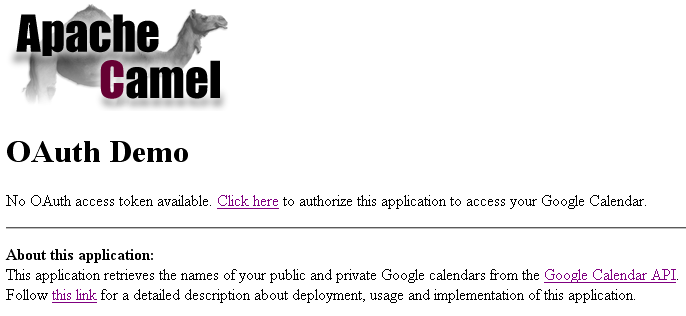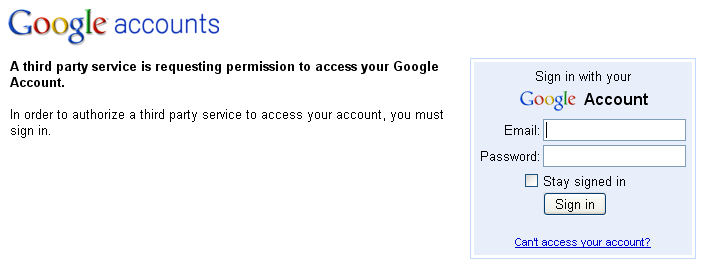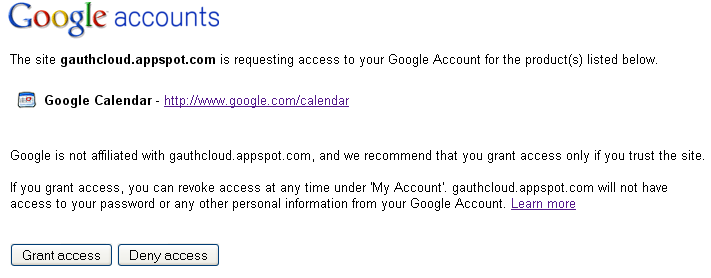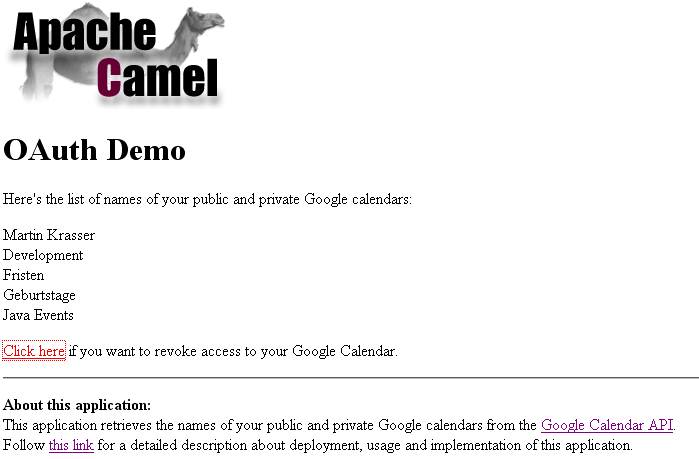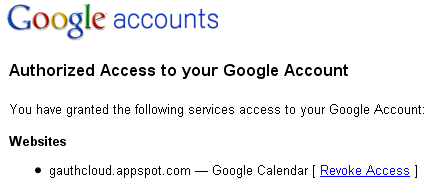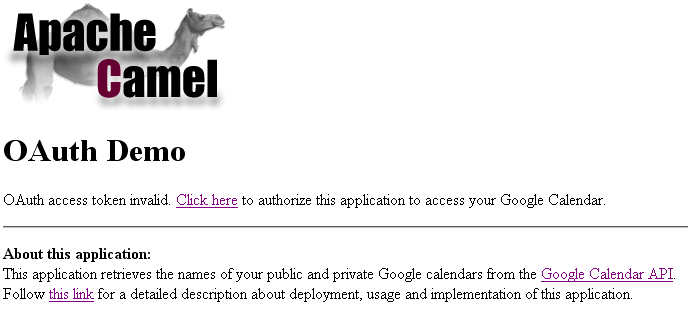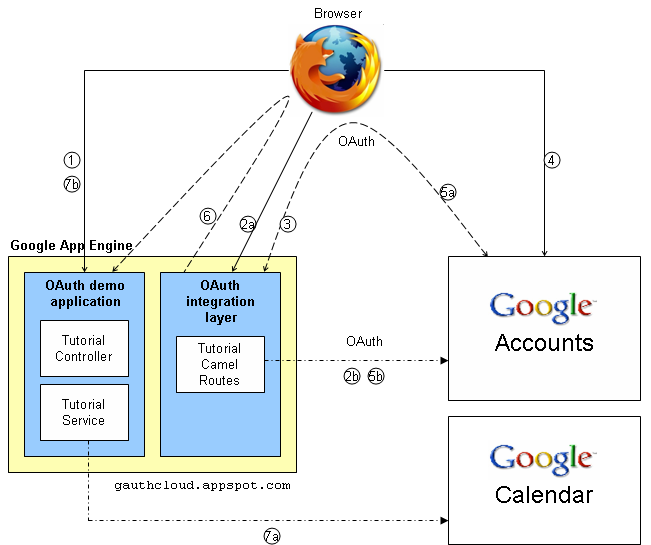Since we're on a major migration process of this website, some component documents here are out of sync right now. In the meantime you may want to look at the early version of the new website
https://camel.apache.org/staging/
We would very much like to receive any feedback on the new site, please join the discussion on the Camel user mailing list.
Camel OAuth TutorialOverviewGoal of this tutorial is to demonstrate how to implement an OAuth consumer with Apache Camel. In this tutorial, the OAuth consumer is a simple web application running on Google App Engine. It reads data from a user's Google Calendar i.e. it displays the names of the user's public and private calendars. The OAuth-based authorization process that allows the application to access a user's calendars is implemented using Camel's gauth component. The application was accessible online at http://gauthcloud.appspot.com/oauth/calendar (but not any more in year 2015 onwards) (later, it will be explained how to build and deploy the application yourself). Play with it by following these steps:
Standalone web applications Camel's OAuth support is not limited to web applications running on Google App Engine. It works for standalone web applications as well as long as they are accessible from the internet so that Google can make OAuth callbacks. ArchitectureThe following figure sketches the architcture of the distributed web application and an example sequence of interactions. Application components
Sequence of actions
Storage of access tokens In production systems it is not recommended to store access tokens in cookies. The recommended approach is to store them in a database. The demo application is only doing that to keep the example as simple as possible. However, an attacker could not use an access token alone to get access to a user's calendar data because the application's consumer secret is necessary for that as well. The consumer secret never leaves the demo application. DeploymentThis section explains how to build and deploy the web application yourself. Prerequisites
Build from sourcesCheckout the sources with svn co http://svn.apache.org/repos/asf/camel/trunk/examples/camel-example-gauth camel-example-gauth Open pom.xml <project xmlns="http://maven.apache.org/POM/4.0.0"
xmlns:xsi="http://www.w3.org/2001/XMLSchema-instance"
xsi:schemaLocation="http://maven.apache.org/POM/4.0.0 http://maven.apache.org/maven-v4_0_0.xsd">
...
<properties>
<!-- application properties -->
<gae.application.name>gauthclaud</gae.application.name>
<gae.consumer.key>gauthcloud.appspot.com</gae.consumer.key>
<gae.consumer.secret>g2e...ue</gae.consumer.secret>
...
</properties>
...
</project>
or pom.xml <project xmlns="http://maven.apache.org/POM/4.0.0"
xmlns:xsi="http://www.w3.org/2001/XMLSchema-instance"
xsi:schemaLocation="http://maven.apache.org/POM/4.0.0 http://maven.apache.org/maven-v4_0_0.xsd">
...
<properties>
<!-- application properties -->
<gae.application.name>gauthclaud</gae.application.name>
<gae.consumer.key>anonymous</gae.consumer.key>
<gae.consumer.secret>anonymous</gae.consumer.secret>
...
</properties>
...
</project>
if you don't want to register your application. Then go to the mvn install This will create the application Deploy to AppengineFinally use the appcfg update target/camel-example-gauth-<version> where Potential issue when using appcfg from the GAE SDK It is important that you run Code walkthroughApplication controllerEntry point to the demo application is the TutorialController.java package org.apache.camel.example.gauth;
import java.util.List;
import javax.servlet.http.Cookie;
import javax.servlet.http.HttpServletRequest;
import javax.servlet.http.HttpServletResponse;
import com.google.gdata.util.AuthenticationException;
import org.springframework.beans.factory.annotation.Autowired;
import org.springframework.stereotype.Controller;
import org.springframework.ui.ModelMap;
import org.springframework.web.bind.annotation.RequestMapping;
import org.springframework.web.bind.annotation.RequestMethod;
/**
* Single controller for the demo application that handles GET requests. Obtains OAuth access
* token and access token secret from cookies and uses them to obtain calendar names from the
* Google Calendar API. If the interaction with the calendar API fails due to invalid or non-
* existing OAuth tokens an error message is displayed in authorize.jsp. If it succeeds the
* calendar names are displayed in calendar.jsp.
* <p>
* In production systems it is <em>not</em> recommended to store access tokens in cookies. The
* recommended approach is to store them in a database. The demo application is only doing that
* to keep the example as simple as possible. However, an attacker could not use an access token
* alone to get access to a user's calendar data because the application's consumer secret is
* necessary for that as well. The consumer secret never leaves the demo application.
*/
@Controller
@RequestMapping("/calendar")
public class TutorialController {
@Autowired
private TutorialService service;
@SuppressWarnings("unchecked")
@RequestMapping(method = RequestMethod.GET)
public String handleGet(
HttpServletRequest request,
HttpServletResponse response,
ModelMap model) throws Exception {
List<String> calendarNames = null;
// Get OAuth tokens from cookies
String accessToken = getAccessToken(request);
String accessTokenSecret = getAccessTokenSecret(request);
if (accessToken == null) {
model.put("message", "No OAuth access token available");
return "/WEB-INF/jsp/authorize.jsp";
}
try {
// Get calendar names from Google Calendar API
calendarNames = service.getCalendarNames(accessToken, accessTokenSecret);
} catch (AuthenticationException e) {
model.put("message", "OAuth access token invalid");
return "/WEB-INF/jsp/authorize.jsp";
}
model.put("calendarNames", calendarNames);
return "/WEB-INF/jsp/calendar.jsp";
}
private static String getAccessToken(HttpServletRequest request) {
return getCookieValue(request.getCookies(), "TUTORIAL-ACCESS-TOKEN");
}
private static String getAccessTokenSecret(HttpServletRequest request) {
return getCookieValue(request.getCookies(), "TUTORIAL-ACCESS-TOKEN-SECRET");
}
// rest of code not shown ...
}
Application serviceAccess to the Google Calendar API is encapsulated in the TutorialService.java package org.apache.camel.example.gauth;
import java.net.URL;
import java.util.ArrayList;
import java.util.List;
import java.util.Properties;
import com.google.gdata.client.authn.oauth.OAuthHmacSha1Signer;
import com.google.gdata.client.authn.oauth.OAuthParameters;
import com.google.gdata.client.calendar.CalendarService;
import com.google.gdata.data.calendar.CalendarEntry;
import com.google.gdata.data.calendar.CalendarFeed;
/**
* Facade for getting calendar names from the Google Calendar API. The access is made on
* behalf of a user by providing an OAuth access token and access token secret.
*/
public class TutorialService {
private Properties credentials;
/**
* Sets properties that contains the application's consumer key and consumer secret.
*
* @param credentials consumer key and consumer secret.
*/
public void setCredentials(Properties credentials) {
this.credentials = credentials;
}
/**
* Obtains a list of names of a user's public and private calendars from the Google
* Calendar API.
*
* @param accessToken OAuth access token.
* @param accessTokenSecret OAuth access token secret.
* @return list of names of a user's public and private calendars.
*/
public List<String> getCalendarNames(String accessToken, String accessTokenSecret) throws Exception {
CalendarService calendarService = new CalendarService("apache-camel-2.3");
OAuthParameters params = getOAuthParams(accessToken, accessTokenSecret);
calendarService.setOAuthCredentials(params, new OAuthHmacSha1Signer());
URL feedUrl = new URL("http://www.google.com/calendar/feeds/default/");
CalendarFeed resultFeed = calendarService.getFeed(feedUrl, CalendarFeed.class);
ArrayList<String> result = new ArrayList<String>();
for (int i = 0; i < resultFeed.getEntries().size(); i++) {
CalendarEntry entry = resultFeed.getEntries().get(i);
result.add(entry.getTitle().getPlainText());
}
return result;
}
private OAuthParameters getOAuthParams(String accessToken, String accessTokenSecret) {
OAuthParameters params = new OAuthParameters();
params.setOAuthConsumerKey(credentials.getProperty("consumer.key"));
params.setOAuthConsumerSecret(credentials.getProperty("consumer.secret"));
params.setOAuthToken(accessToken);
params.setOAuthTokenSecret(accessTokenSecret);
return params;
}
}
The Integration layerThe integration layer uses Camel's gauth component to implement the consumer part of the OAuth authorization process. It cleanly separates OAuth integration logic from other parts of the application and is implemented by the TutorialRouteBuilder.java package org.apache.camel.example.gauth;
import java.net.URLEncoder;
import org.apache.camel.builder.RouteBuilder;
/**
* Builds the OAuth-specific routes (implements the OAuth integration layer) of the demo application.
*/
public class TutorialRouteBuilder extends RouteBuilder {
private String application;
/**
* Sets the name of the GAE application.
*
* @param application a GAE application name.
*/
public void setApplication(String application) {
this.application = application;
}
@Override
public void configure() throws Exception {
// Callback URL for sending back an authorized access token.
String encodedCallback = URLEncoder.encode(
String.format("https://%s.appspot.com/camel/handler", application), "UTF-8");
// Google should issue an access token that is scoped to calendar feeds.
String encodedScope = URLEncoder.encode("http://www.google.com/calendar/feeds/", "UTF-8");
// Route for obtaining an unauthorized request token from Google Accounts. The
// response redirects the browser to an authorization page provided by Google.
from("ghttp:///authorize")
.to("gauth:authorize?callback=" + encodedCallback + "&scope=" + encodedScope);
// Handles callbacks from Google Accounts which contain an authorized request token.
// The authorized request token is upgraded to an access token which is stored in
// the response message header. The TutorialTokenProcessor is application-specific
// and stores the access token (plus access token secret) is cookies. It further
// redirects the user to the application's main location (/oauth/calendar).
from("ghttp:///handler")
.to("gauth:upgrade")
.process(new TutorialTokenProcessor());
}
}
This class implements two routes:
The last step in the second route is an application-specific processor ( TutorialTokenProcessor.java package org.apache.camel.example.gauth;
import javax.servlet.http.Cookie;
import javax.servlet.http.HttpServletResponse;
import org.apache.camel.Exchange;
import org.apache.camel.Processor;
import static org.apache.camel.component.gae.auth.GAuthUpgradeBinding.GAUTH_ACCESS_TOKEN;
import static org.apache.camel.component.gae.auth.GAuthUpgradeBinding.GAUTH_ACCESS_TOKEN_SECRET;
/**
* Reads an OAuth access token plus access token secret from a Camel message and stores them in
* cookies. These cookies are needed by {@link org.apache.camel.example.gauth.TutorialController}
* for accessing a user's calendar via the Google Calendar API. The cookies are valid for one
* hour. Finally, it generates an HTTP 302 response that redirects the user to the application's
* main location (/oauth/calendar).
* <p>
* In production systems it is <em>not</em> recommended to store access tokens in cookies. The
* recommended approach is to store them in a database. The demo application is only doing that
* to keep the example as simple as possible. However, an attacker could not use an access token
* alone to get access to a user's calendar data because the application's consumer secret is
* necessary for that as well. The consumer secret never leaves the demo application.
*/
public class TutorialTokenProcessor implements Processor {
private static final int ONE_HOUR = 3600;
public void process(Exchange exchange) throws Exception {
String accessToken = exchange.getIn().getHeader(GAUTH_ACCESS_TOKEN, String.class);
String accessTokenSecret = exchange.getIn().getHeader(GAUTH_ACCESS_TOKEN_SECRET, String.class);
if (accessToken != null) {
HttpServletResponse servletResponse = exchange.getIn().getHeader(
Exchange.HTTP_SERVLET_RESPONSE, HttpServletResponse.class);
Cookie accessTokenCookie = new Cookie("TUTORIAL-ACCESS-TOKEN", accessToken);
Cookie accessTokenSecretCookie = new Cookie("TUTORIAL-ACCESS-TOKEN-SECRET", accessTokenSecret);
accessTokenCookie.setPath("/oauth/");
accessTokenCookie.setMaxAge(ONE_HOUR);
accessTokenSecretCookie.setPath("/oauth/");
accessTokenSecretCookie.setMaxAge(ONE_HOUR);
servletResponse.addCookie(accessTokenCookie);
servletResponse.addCookie(accessTokenSecretCookie);
}
exchange.getOut().setHeader(Exchange.HTTP_RESPONSE_CODE, 302);
exchange.getOut().setHeader("Location", "/oauth/calendar");
}
}
For further details about implementing OAuth integration layers in web application refer to the gauth component documentation. ConfigurationThe context-web.xml <beans xmlns="http://www.springframework.org/schema/beans"
xmlns:xsi="http://www.w3.org/2001/XMLSchema-instance"
xmlns:ctx="http://www.springframework.org/schema/context"
xmlns:util="http://www.springframework.org/schema/util"
xsi:schemaLocation="
http://www.springframework.org/schema/beans
http://www.springframework.org/schema/beans/spring-beans-2.5.xsd
http://www.springframework.org/schema/context
http://www.springframework.org/schema/context/spring-context-2.5.xsd
http://www.springframework.org/schema/util
http://www.springframework.org/schema/util/spring-util-2.5.xsd">
<ctx:component-scan base-package="org.apache.camel.example.gauth"/>
<util:properties id="credentials" location="classpath:context.properties"/>
<bean id="tutorialService" class="org.apache.camel.example.gauth.TutorialService">
<property name="credentials" ref="credentials" />
</bean>
</beans>
The integration layer and its context-camel.xml <beans xmlns="http://www.springframework.org/schema/beans"
xmlns:xsi="http://www.w3.org/2001/XMLSchema-instance"
xmlns:context="http://www.springframework.org/schema/context"
xmlns:camel="http://camel.apache.org/schema/spring"
xsi:schemaLocation="
http://www.springframework.org/schema/beans
http://www.springframework.org/schema/beans/spring-beans-2.5.xsd
http://www.springframework.org/schema/context
http://www.springframework.org/schema/context/spring-context-2.5.xsd
http://camel.apache.org/schema/spring
http://camel.apache.org/schema/spring/camel-spring.xsd">
<context:property-placeholder location="classpath:context.properties"/>
<camel:camelContext id="camelContext">
<camel:jmxAgent id="agent" disabled="true" />
<camel:routeBuilder ref="tutorialRouteBuilder"/>
</camel:camelContext>
<bean id="tutorialRouteBuilder"
class="org.apache.camel.example.gauth.TutorialRouteBuilder">
<property name="application" value="${application.name}" />
</bean>
<bean id="gauth" class="org.apache.camel.component.gae.auth.GAuthComponent">
<property name="consumerKey" value="${consumer.key}" />
<property name="consumerSecret" value="${consumer.secret}" />
</bean>
</beans>
Both application contexts are referenced in the application's web.xml <web-app
xmlns="http://java.sun.com/xml/ns/javaee"
xmlns:xsi="http://www.w3.org/2001/XMLSchema-instance"
xmlns:web="http://java.sun.com/xml/ns/javaee/web-app_2_5.xsd"
xsi:schemaLocation="
http://java.sun.com/xml/ns/javaee
http://java.sun.com/xml/ns/javaee/web-app_2_5.xsd" version="2.5">
<servlet>
<servlet-name>CamelServlet</servlet-name>
<servlet-class>org.apache.camel.component.servlet.CamelHttpTransportServlet</servlet-class>
<init-param>
<param-name>contextConfigLocation</param-name>
<param-value>context-camel.xml</param-value>
</init-param>
</servlet>
<servlet>
<servlet-name>oauth</servlet-name>
<servlet-class>org.springframework.web.servlet.DispatcherServlet</servlet-class>
<init-param>
<param-name>contextConfigLocation</param-name>
<param-value>/WEB-INF/classes/context-web.xml</param-value>
</init-param>
</servlet>
<servlet-mapping>
<servlet-name>oauth</servlet-name>
<url-pattern>/oauth/*</url-pattern>
</servlet-mapping>
<servlet-mapping>
<servlet-name>CamelServlet</servlet-name>
<url-pattern>/camel/*</url-pattern>
</servlet-mapping>
</web-app>
|
